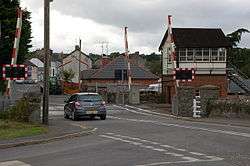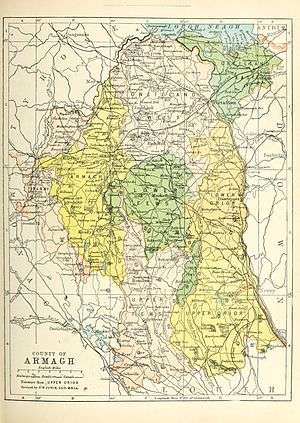Poyntzpass

Poyntzpass (Irish: Pas Phoyntz or Pas an Phointe) is a small village on the border between southern County Armagh and County Down in Northern Ireland. It is situated in the civil parish of Ballymore and the historic barony of Orior Lower.[1] and is within the Armagh City and District Council area. It had a population of 614 people (255 households) in the 2011 Census.[2] It was a part of the South Armagh constituency and is part of the Newry and Armagh constituency, and was one of the places in South Armagh where the Ulster Covenant could be signed.[3]
The village covers the townlands of Tullynacross, Brannock, Federnagh and Loughadian. It includes five places of Christian worship; a Roman Catholic Church, a Church of Ireland Church, a Presbyterian Church, a Baptist Church, and an Independent Church; 3 public houses; and 2 primary schools.
History
Originally called Curriator (sometimes Kirriotter) by Pynnar in his survey of Ulster, it later got its current name.
The second half of the village's name reflects the fact that, historically, it was one of a few crossing points across a marsh stretching 25 miles (40 km) from Lough Neagh to Carlingford Lough, following the course of a prehistoric glacial overflow channel. It is on a major north-south route and was named after Lieutenant Charles Poyntz from Iron Acton, Gloucestershire who defended it against Hugh O'Neill, 3rd Earl of Tyrone in 1598.
From "Topographical Dictionary of Ireland" by Samuel Lewis, 1837:
"POYNTZPASS, or FENWICK'S PASS, a small town, partly in the parish of AGHADERG, barony of UPPER IVEAGH, county of DOWN, but chiefly in the parish of BALLYMORE barony of LOWER ORIOR, county of ARMAGH and province of ULSTER , 2¾ miles (S.W.) from Loughbrickland, to which it has a penny post; containing 660 inhabitants, of which number, 88 are in the county of Down. This place was an encumbered pass through bogs and woods, from the county of Down into that of Armagh, and from the O'Hanlons' to the Magennises' country: it derives its present name from this important military position having been forced, after a desperate action, by Lieut. Poyntz, of the English army, with a few troops, against a numerous body of Tyrone's soldiers, for which service he was rewarded with a grant of 500 acres [2 km²] in this barony: there are some remains of the castle that commanded the pass. At Drumbanagher are vestiges of the entrenchment surrounding the principal strong hold of the Earl of Tyrone, during his wars with Queen Elizabeth, called Tyrone's Ditches. Poyntz-Pass is now one of the most fertile and beautiful spots in this part of the country. To the south is Drumbanagher Castle, the handsome residence of Lieut.-Col. Maxwell Close, built in the Italian style, with a large portico in front; on an eminence above the town is Acton House, the elegant residence of C. R. Dobbs, Esq.; not far from which is Union Lodge, that of W. Fivey, Esq., in a beautiful demesne, bounded by the extensive waters of Lough Shark. That portion of the town which is in the county of Armagh was built about 1790, by Mr. Stewart, then proprietor, who procured for it a grant of a market and fairs; the former was never established, but the latter, held on the first Saturday in every month, are large and well attended, great numbers of cattle and sheep being sold. The town comprises 116 houses in one principal street, intersected by a shorter one. It contains the church for the district of Acton, a small neat edifice in the early English style, with a tower at the east front, built in 1789, and considerably enlarged and improved in 1829; a R. C. chapel, a school, and a constabulary police station."
A castle was once situated in Poyntzpass. Its remnants were visible until the middle of the 19th century, but there is now no trace of it other than in the name 'Castle Corner' by which a corner of William Street is sometimes known.
On 3 March 1998, 26-year old Catholic Damian Trainor and 34-year old Protestant Philip Allen, were shot dead during a Loyalist Volunteer Force gun attack on the Railway Bar in Poyntzpass.[4]
Local surnames
In 1910, these surnames were recorded in Poyntzpass in the Ulster towns directory.[5]
- Acheson, Adams, Agnew, Alderdice, Allen, Andrew, Andrews, Barber, Bicker, Brown, Burns, Campbell, Canavan, Carson, Carter, Clark, Clowney, Close, Conlon, Corry, Coulter, Crothers, Cunningham, Cully, Daly, Denny, Finch, Hollow, Fisher, Flanigan, Foy, Gibson, Gilleland, Gordon, Graham, Griffith, Guy, Hanna, Harden, Henry, Humphrey, Hunter, Johnson, Johnston, Kelso, Laverty, Lennon, Little, Loughlin, O'Loughlin, Madden, Magenis, Maloney, Man, Matthews, Milne, Monaghan, Moody, Moorcroft, Morrow, Murphy, Murray, McClelland, McComb, MacCullough, McDonald, McDowell, McElroy, McElvaine, McGaw, McGill/Magill, McKelvey, McLean, McMurray, McSherry, Qua, Quin, Rafferty, Reside, Rice, Robinson, Ryan, Ryder, Savage, Searight, Shanks, Sleith, Stewart, Stuart, Strain, Traynor/Trainor, Vint, Waddell , Walsh, Ward, White, Williamson, Wilkinson, Wilson, Wright and Wylie.
Surnames local to Poyntzpass and surrounding areas (such as Drumbanagher or Lissummon) that are not included in this survey from 1910, do appear in the 1911 census of the Poyntz Pass area.[6] A few of these names are:
- Alexander, Best, O'Callaghan, Calvert, Convery, Hanlon, Hanratty, Hudson, Ligget, Mackle, McCourt, McKeown, McVeigh, McVerry, Meehan, Minnis, Morton, O'Hagan, Sheals, Shevlin, Sterritt, Stevenson and Teggart.
Notable Poyntzpass people
- The 17th century rapparee Redmond O'Hanlon was a Poyntzpass native.
- Charles Davis Lucas, first recipient of the Victoria Cross, in 1857, was born and grew up nearby.
- Dr W R MacDermott, the local dispensary doctor, published his novel "The Green Republic" in 1904, under the penname A P A O'Gara. His fictional village of Jigglestreet was closely based on Poyntzpass and many of its inhabitants.[7]
Sport
The local Gaelic football club, named in honour of the rapparee, is Redmond O'Hanlon's (Cumann Réamainn Uí Anluain). Created around 1960, it became inactive in 1970 but was revived in 1977. It currently competes at Junior level in county competitions, and combines with Whitecross and Lissummon to field Minor teams as St Brigid's.[8]
Transport
Poyntzpass straddles the main Belfast-Dublin railway line, and has a Northern Ireland Railways railway station. Poyntzpass railway station was opened on 6 January 1862.[9]
The Newry Canal which flows through Poyntzpass follows the Armagh/Down border and was one of the first major canals to be constructed in Britain or Ireland. However, it never really fulfilled its promise to bring industry and prosperity and has been derelict since the 1940s. Its summit level is one mile (1.6 km) from the village at Acton Lake (Lough Shark).
Education
- Poyntzpass Primary School
- St Joseph and St James's Primary School
References
- ↑ "Poyntzpass". IreAtlas Townlands Database. Retrieved 13 May 2015.
- ↑ "Poyntzpass". Census 2011 Results. NI Statistics and Research Agency. Retrieved 30 April 2015.
- ↑ Loyalism in the Fews from the 17th Century, Newry Journal, http://www.newryjournal.co.uk/2011/02/20/loyalism-in-fews-from-17th-century/
- ↑ http://cain.ulst.ac.uk/sutton/chron/ NI Conflict Archive on the Internet
- ↑ Library Ireland, Ulster Towns directory 1910 Poyntzpass, libraryireland.com
- ↑ , census.nationalarchives.ie
- ↑ The Green Republic on Amazon Books
- ↑ Armagh GAA website Archived 2012-08-27 at the Wayback Machine.
- ↑ "Poyntzpass station" (PDF). Railscot - Irish Railways. Retrieved 2007-08-28.
Sources
External links
- Poyntzpass Silver Band
- 'From Ireland' © Jane Lyons, Dublin, Ireland
- Landscapes Unlocked - Aerial footage from the BBC Sky High series explaining the physical, social and economic geography of Northern Ireland.
- The Meeting Place - Poyntzpass Community Centre.
- Poyntzpass Presbyterian Church
